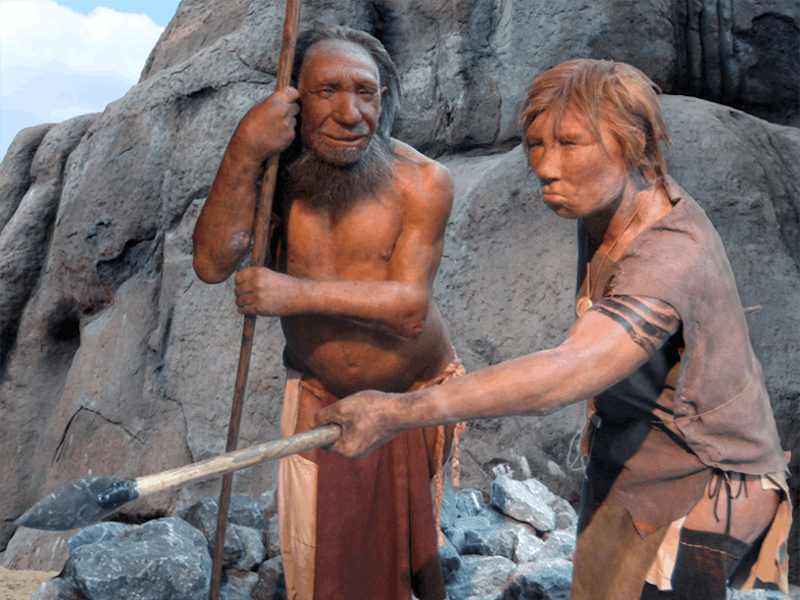A common ear infection may have been the reason Neanderthals died off, study finds
What Homo sapiens grow out of with age may have plagued Neanderthals much longer.

What killed the Neanderthals has been a question that’s long plagued anthropologists. Previously, researchers have suggested this extinction may have been the result of a plague or environmental disaster, but new research suggests it might be something far more common.
Scientists reported this week in the journal The Anatomical Record that an ear infection common in children might be a leading reason the Neanderthals died out.
In humans, ear infections happen primarily during childhood as a result of our inner ear tubes, scientifically referred to as Eustachian tubes, not having yet grown to their fully formed adult structure. Instead, they are short and have a shallow angle in our skulls, allowing harmful bacteria to linger and cause infections such as pneumonia or meningitis. Today, if a baby or young child is suffering from an ear infection, they can quickly be treated with antibiotics.
After the age of 5, most children will grow out of their ear infections as the angle and length of their tubes change, but in the study published on Thursday, researchers found that Neanderthal tubes never matured past the short, infant stage of Homo sapiens, and as a result, they may have left some Neanderthals very sick a lot of the time.
To determine this similarity between the Eustachian tubes of young Homo sapiens and Neanderthals, the team created a first of its kind reconstruction of Neanderthals’ Eustachian tubes using preserved, fossilized crania and compared it to that of over 200 human samples with variation between different ethnic populations and ages. By studying the Neanderthal skulls, the team was able to reconstruct what their Eustachian tubes may have looked like based on their cranial anatomy and found similarities between that reconstruction and a human infant’s tubes, suggesting that the Neanderthals may have also suffered from the same ear infections human infants do.
“Here is yet another intriguing twist on the ever-evolving Neanderthal story, this time involving a part of the body that researchers had almost entirely neglected,” Ian Tattersall, Ph.D., paleoanthropologist and curator emeritus of the American Museum of National History, said in a statement released with the research. “It adds to our gradually emerging picture of the Neanderthals as very close relatives who nonetheless differed in crucial respects from modern man.”
Neanderthals may have suffered from chronic ear infections that human children typically outgrow.
And, while the ear infections may not have necessarily killed them, researchers hypothesize that constant sickness as a result may have been at an evolutionary disadvantage to Neanderthals when it came to having energy and ability to out compete Homo sapiens in order to survive.
Samuel Márquez, Ph.D., a co-investigator and associate professor at SUNY Downstate Health Sciences University, tells Inverse the Neanderthals died off over time.
“When you have two species occupying the same ecological niche, you need to be most fit in order to compete for valuable resources with your competitors,” Márquez says. “If you are not as fit, then you would be compromised and unable to sustain your group’s survival. … It was not a cataclysmic event, but a gradual one.”
This illustration shows the structure of the Eustachian tube in a Neanderthal man and its similarity to the human infant.
While the results in the study may have been determined from just a few samples, Márquez tells Inverse that it does still have wide significance nonetheless.
“The fact that these three randomly and geographically distinct individuals shows this characteristic says something about this species,” Márquez said in the email. “We had two more adult individuals that although did not meet our protocol for our study, nevertheless showed the same flat angle anatomy of the Eustachian tube, which strongly supports the hypothesis that the flat angle cartilaginous Eustachian tube is an inherent morphological trait of Neanderthals. Our next step is to now document younger Neanderthal specimens, which is now underway.”
Abstract:
Neanderthals are among the best studied and yet most enigmatic fossil human groups with aspects of their anatomy and functional morphology remaining poorly understood. We present the first anatomical reconstruction of the Neanderthal cartilaginous Eustachian tube (CET), a vital component of the upper respiratory tract and nexus for the middle ear and postnasal airway. The Eustachian (auditory, pharyngotympanic) tube, comprised of a bony and cartilaginous (CET) portion, is integral to normal physiological functions such as middle ear aeration and pressure equilibration. Findings indicate that Neanderthal tubal morphology may have predisposed them to high rates of middle ear disease (otitis media [OM]). In living humans, mechanical CET dysfunction underlies OM in infants and young children, with sequelae including hearing loss, meningitis, and pneumonia. Despite proven linkage of CET malfunction with OM, the role of CET morphology in Neanderthal health and disease remains unstudied. We reconstructed Neanderthal CET morphology, comparing their crania to a modern human growth series. Methods included geometric morphometrics and univariate measures among Procrustes-fitted coordinates. Results showed Neanderthal adults exhibiting primitively tall and narrow nasopharynges with infant-like horizontal CET and choanal orientation. As horizontal CET orientation is associated with increased OM incidence in infants and children until around age six, its appearance in Neanderthal adults strongly indicates persistence of high OM susceptibility at this time. This could have compromised fitness and disease load relative to sympatric modern humans, affecting Neanderthals’ ability to compete within their ecological niche, and potentially contributing to their rapid extinction.